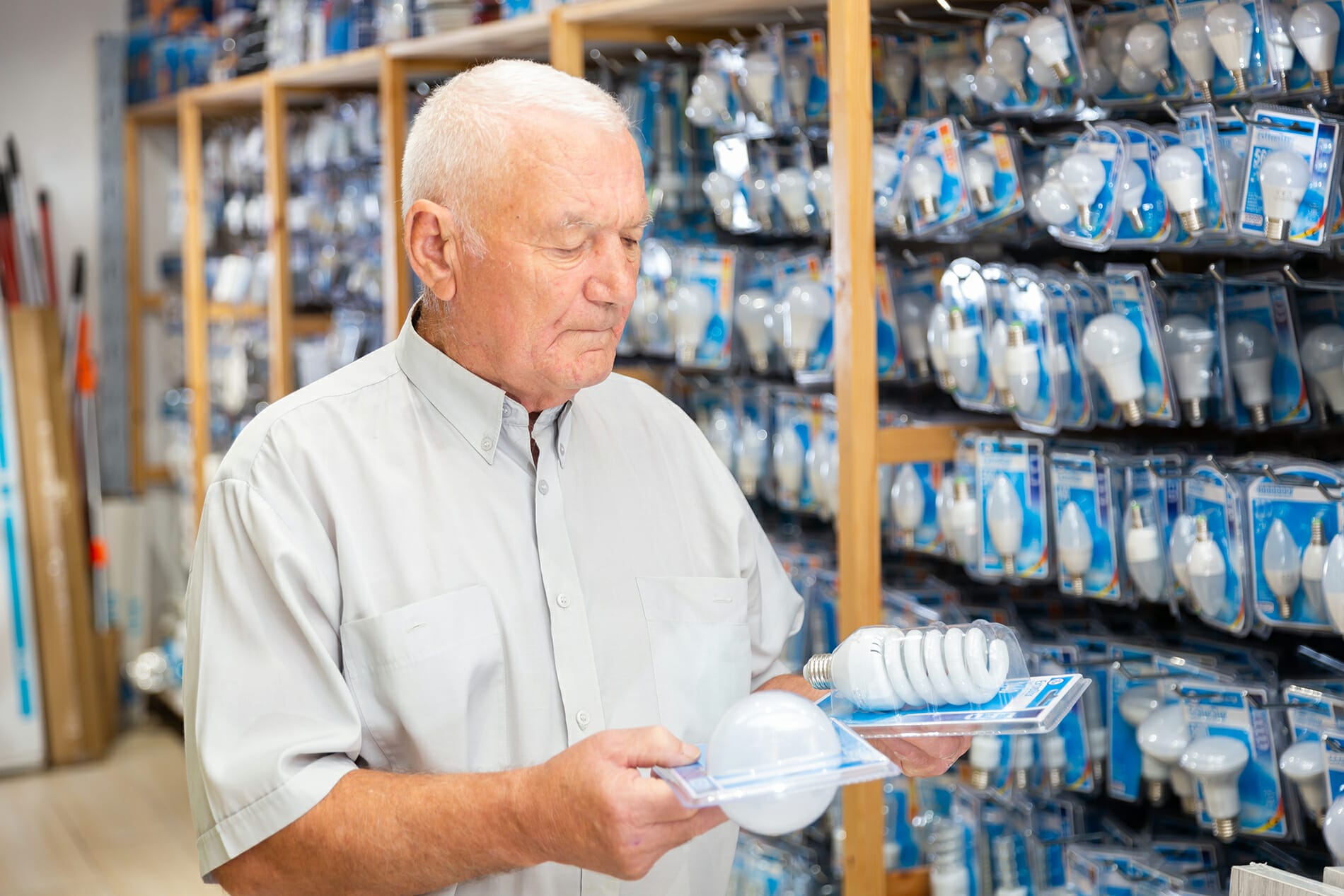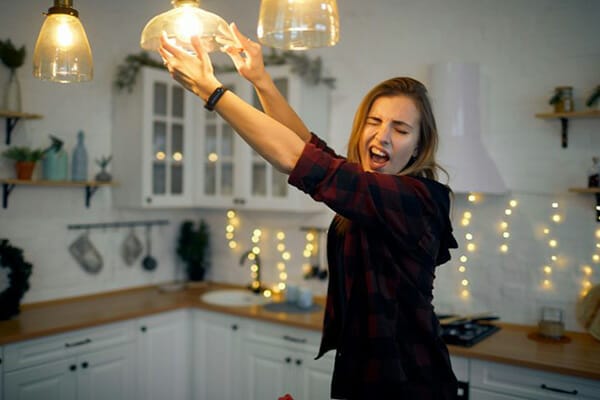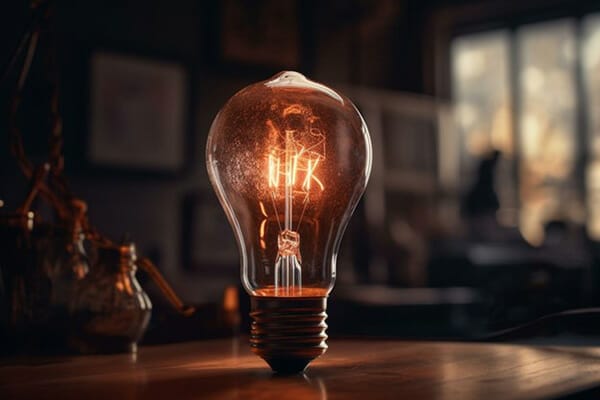Installing energy-efficient light bulbs is a simple way to tackle rising energy costs. As the name suggests, energy-efficient light bulbs use less energy, reducing a home or business’s energy consumption. It’s a false economy, some claim, because most energy-efficient light bulbs are more expensive to buy than their halogen cousins.
However, the U.S. Environmental Protection Agency (EPA) says if every American switched one incandescent light bulb with an Energy Star-approved bulb, it would save the greenhouse gas emissions of 550,000 cars.
This guide to energy-efficient light bulbs will explain why LED bulbs are the most energy-efficient option available. You’ll also learn why ditching traditional incandescent bulbs makes sense for your pocket and the environment in the long term.
Why Do We Need Energy-Efficient Light Bulbs?
To be clear, the Energy Independence and Security Act of 2007 didn’t ban traditional incandescent bulbs. It set out new energy-efficient lighting goals, increasing their energy efficiency by 25-30%. That is today, 25% less energy use.
The primary target was the cheap halogen light bulbs many people use at home and in offices. Many specialty bulbs — like refrigerator bulbs, chandeliers, and plant grow lights — are exempt.
The federal government-led initiative aimed to reduce America’s power demands through energy-saving measures. It estimates that by 2035, the nation will save 569 terawatt hours annually through the widespread use of LED lighting. That means not building dozens of power plants just to light our buildings.
CFL and LED: What Are the Types of Energy-Efficient Light Bulbs?
Let’s understand the many different types of light bulbs available on the market. You can buy most of these light bulbs from brick-and-mortar or online retailers.
Incandescent Light Bulbs
These traditional light bulbs are cheap to manufacture and versatile. They work with timers, dimmers, and motion sensors and have Edison screws or Philips bulb bases. Incandescent light bulbs are the least energy-efficient on the market, with just 5% of their electricity use converting into light and 95% being lost as heat.
Halogen Light Bulbs
Halogen bulbs look similar to incandescent bulbs but have a small capsule covering the filament to improve energy efficiency. Halogen light bulbs often get very hot to the touch.
Standard Fluorescent Light Bulbs
These bulbs are instantly recognizable as long fluorescent tubes in commercial and outdoor lighting. They’re renowned for their low cost, longevity, and energy efficiency.
Compact Fluorescent Light Bulbs (CFLs)
CFLs were the first energy-efficient light bulbs on the market. Their curly appearance marked them out from the rest, although round and flame shapes are available nowadays. CFLs use 70-80% less electricity than traditional light bulbs and last about 10 times longer. Not all CFLs are dimmable. They work well where white light is required — e.g., in garages or kitchens. CFLs are also known as compact fluorescent lamps and come with Edison screws or Philips bulb bases.
Enter your ZIP Code and compare electricity rates
Light-Emitting Diode (LED)
LEDs are semiconductors that use 75% less energy and last up to 30 times longer than traditional light bulbs and five times longer than CFLs. LEDs will help people save money on their utility bills. LEDs now come in various colors and wattages and are very versatile. People use them for patios, task lighting, downlights, and more, inside and outside the home.
Smart Bulbs
Smart bulbs are Wi-Fi-enabled LED light bulbs. They can be turned on and off from an app or smart unit like Amazon’s Alexa. Smart bulbs are great for smart homes, helping people monitor their energy usage from a central hub.
What Is the Most Energy-Efficient Light Bulb?
LEDs are the most energy-efficient light bulbs on the market, followed by CFLs and then incandescent light bulbs. That’s because LEDs convert more electricity into light than other bulbs and lose less energy as heat.
For example, the 60-watt equivalent of a traditional light bulb is a 10-watt LED bulb. A 9-13W LED bulb could replace a 100W incandescent light bulb.
Do LED and CFL Bulbs Save on Utility Bills?
Energy-saving light bulbs will save you money on your energy bills, assuming you continue using the same amount of light before the switch.
But LEDs and CFLs generally have a higher sticker price than traditional light bulbs. So which saves you money in the long run?
First, we’ll examine prices for 60W and their equivalent bulbs. We’ll also use the 2022 average U.S. residential electricity price of 15.12 cents per kWh for our examples.
It’s worth noting that prices are rising; in 2021, that average electricity price was 13.66 cents per kWh. As LEDs last the longest, we’ll use their 25,000-hour lifespans as a comparison point.
- A 60W incandescent light bulb costs an average of $1 and lasts around 1,200 hours. That means 21 bulbs ($21) to last 25,000 hours, costing $226.8 to power. Total cost: $247.80.
- The equivalent 14W CFL bulb costs an average of $2 and lasts around 8,000 hours, so we’ll need three ($6) to last 25,000 hours. The energy will cost $52.92. Total cost: $58.92.
- We need one 7W LED bulb equivalent ($4) that lasts 25,000 hours and uses $26.46 of energy. Total cost: $30.46.
LED light bulbs have higher upfront costs but provide more significant savings on energy bills in the long term. The less energy-efficient and cheaper traditional light bulbs may have an attractive over-the-counter price but punish the dollars in your pocket over time.
What Bulbs Can Cut Up to 75% of Your Electric Energy Bill?
LED light bulbs are the bulbs that can save you up to 75% on your electricity bill. Check Energy Star for energy-efficient light bulb advice.
How Much Does It Cost to Run a 60W LED Light Bulb for 24 Hours?
A 7W LED light bulb, the equivalent of a 60W traditional bulb, uses 0.000459959 kWh of energy to remain on for 24 hours.
At 15.12 cents per kWh, keeping that 7W LED light bulb on for 24 hours costs three cents.
A 60W LED or 60W traditional light bulb both use the same amount of electricity, and more than a 7W LED bulb. These 60-watters cost 22 cents to illuminate for 24 hours. The only difference would be that a 60W LED bulb would be much brighter than the 60W traditional light bulb.
Do CFL or LED Bulbs Last Longer?
LED light bulbs (25,000 hours) last longer than both CFLs (8,000 hours) and traditional incandescent bulbs (1,200 hours).
Lumens: Which LED Light Bulb Do I Need to Buy?
Many people think about wattage when buying light bulbs — that is, the higher the wattage, the brighter the bulb. That still holds true with LEDs and CFLs. But it’s not like comparing apples with apples if you’re switching from traditional or CFL light bulbs to LED light bulbs.
Modern LED and CFL light bulbs require us to think about a bulb’s brightness (lumens) and warmth (kelvin) more than its wattage. Let’s deal with brightness and lumens first.
Check the packaging of any bulb you wish to purchase, and it should list its lumens, usually a value between 400 and 2,500. Lumens are the amount of light a bulb emits. This is how to work out the lumens you need to replace your traditional light bulbs.
- 400-500 lumens is equal to an incandescent 40W bulb | 8-12W CFL | 6-7W LED
- 650-850 lumens is equal to an incandescent 60W bulb | 13-18W CFL | 7-10W LED
- 1,000-1,400 lumens is equal to an incandescent 75W bulb | 18-22W CFL | 12-13W LED
- 1,450-1,700+ lumens is equal to an incandescent 100W bulb | 23-30W CFL | 14-20W LED
An 800 lumens, 7-10W LED light bulb is what to buy to replace the 60-watt equivalent traditional light bulb.
The adage about the higher the wattage, the brighter the build still holds. But you’ll need to compare the lumens to make sure you get the equivalent and appropriate lighting.
Kelvin Rating: Warm or Cold Lighting?
Early energy-efficient light bulbs were famous for cool white light, bordering on a cold and industrial feel. Fortunately, things have moved on considerably since then. Energy-efficient light bulbs don’t mean a cool, sterile light in rooms that require a soft white ambiance.
Once you’ve decided on your lumens level, check the packing for its Kelvin rating. Nowadays, many bulb manufacturers label their bulbs as cool white or warm white to help guide your decision-making process.
- A 2,000-3,000 Kelvin rating provides warm lighting for bedrooms or relaxing areas like living and dining rooms.
- A 3,000 Kelvin rating is a soft white light, and 3,500 is a neutral white.
- Choosing a 4,000-4,500 Kelvin rating gives a cool white light similar to sunlight. Kitchens and bathrooms often require this type of lighting so people can see what they are doing.
- You can replicate a blueish, bright daylight effect with a 4,600K to 6,500 Kelvin rating for work areas. Anything above a 6,500 Kelvin rating is a bright and blue light used commercially, often for task lighting.
What Is a Color Rendering Index (CRI)?
LED light bulbs may also carry a color rendering index (CRI) measurement between 0 and 100. A CRI rating describes how well an object’s true colors appear under a light.
For example, a CRI rating of 0 means all colors look the same. Conversely, a 100 CRI rating shows the object’s natural colors. One reason incandescent and halogen bulbs are so popular is that their CRI ratings are usually high and often 100. LED bulbs do well, reaching 97-98 on the CRI scale, but are still not as high as traditional bulbs.
You can’t improve a bulb’s CRI rating by making it brighter with more lumens or shining a cooler light with a higher Kelvin rating.
Which Is Better for Your Eyes, LED or CFL?
LED light bulbs flicker rapidly, producing a barely noticeable blinking effect. Their use in cell phones, television, and laptops on top of light bulbs has been associated with disturbing sleep patterns and retina damage. But most studies show LED light bulbs are safe for your eyes.
Similarly, CFL bulbs are safe for your eyes. The main risk from a CFL bulb is if it breaks and releases some of the mercury it contains.
There are low levels of UV radiation emitted by some halogen and fluorescent light bulbs. However, an Australian Radiation Protection and Nuclear Safety Agency study found no lamp produced enough UV radiation to damage humans.
Who Invented the Light Bulb?
Contrary to popular belief, it wasn’t Thomas Edison who invented the light bulb, although he played a vital role in the light bulb’s mass adoption.
In 1792, William Murdoch lit his house with coal and gas lights, leading to natural gas street lights in London’s Pall Mall by 1807. By coincidence, that same year, English chemist Sir Humphry Davy constructed the forerunner to light bulbs called an electric arc lamp. Davy’s invention is still used wherever bright light is required, such as floodlights, film sets, or searchlights.
Next, in 1840, British scientist Warren de la Rue built a light bulb with a filament. Its platinum filament made it costly. Twenty years later, English chemist Joseph Swan invented a lamp that used cheaper carbonized paper filaments.
What Thomas Edison did was a similar filament swap, using a thin carbon filament to create a lot of light from little power. In fact, his researcher, the Black inventor Lewis Howard Latimer, further improved the system by adding a carbonized bamboo filament.
The real mainstream breakthrough came in 1910 when U.S. physicist and engineer William David Coolidge produced tungsten cheaply. Tungsten has the highest melting point of any element, making it relatively bright and efficient in a light bulb.
Use Energy-Efficient Light Bulbs to Lower Your Energy Bills and Emissions
Technological advances have provided us with energy-efficient light bulbs that illuminate our homes and offices however we wish. Traditional light bulbs have served us well until now, but the need to reduce our energy consumption while maintaining our lifestyles makes a switch necessary.
It’s true that LEDs have higher upfront prices than CFLs and traditional light bulbs. But LEDs save up to 75% on energy bills over their long lifetimes. Positively, there are a variety of brightness and tones alongside a myriad of designs, from spots to outdoor lights to decorative chains.
Converting to LEDs is just one of many energy-efficiency measures that help reduce our greenhouse gas emissions. Light is also a symbol of human perseverance and hope. What better way to battle for a cleaner planet than doing so every time we switch on the lights?
Brought to you by energysavings.com
All images licensed from Adobe Stock.




